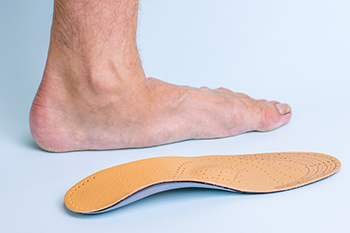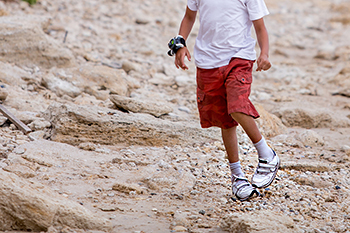Items filtered by date: November 2022
Is Having Flat Feet a Problem?

Having flat feet is when one stands on a flat surface and their entire foot is in contact with that surface, with no visible arch. This condition used to be considered a problem and even used to bar one from military service. While flat feet can be an indicator of poor biomechanics or walking style, they do not always cause problems. Babies are born with flat feet and do not have a foot arch until it is filled with fat as they develop. If the arch drops later in life, it is known as acquired flat foot. This is sometimes associated with problems, like excessive pronation or the foot rolling inward and lowering the arch closer to the ground. Problems with the feet can lead to problems elsewhere in the body, such as knees, hips, and the back. If you have flat feet and they cause you pain, see a podiatrist for an examination and guidance.
Flatfoot is a condition many people suffer from. If you have flat feet, contact Dr. Steven Sheridan from Ankle & Foot Specialty Clinics. Our doctor will treat your foot and ankle needs.
What Are Flat Feet?
Flatfoot is a condition in which the arch of the foot is depressed and the sole of the foot is almost completely in contact with the ground. About 20-30% of the population generally has flat feet because their arches never formed during growth.
Conditions & Problems:
Having flat feet makes it difficult to run or walk because of the stress placed on the ankles.
Alignment – The general alignment of your legs can be disrupted, because the ankles move inward which can cause major discomfort.
Knees – If you have complications with your knees, flat feet can be a contributor to arthritis in that area.
Symptoms
- Pain around the heel or arch area
- Trouble standing on the tip toe
- Swelling around the inside of the ankle
- Flat look to one or both feet
- Having your shoes feel uneven when worn
Treatment
If you are experiencing pain and stress on the foot you may weaken the posterior tibial tendon, which runs around the inside of the ankle.
If you have any questions please feel free to contact our office located in Sandusky, MI . We offer the newest diagnostic and treatment technologies for all your foot and ankle needs.
Is Having Flat Feet a Problem?

Having flat feet is when one stands on a flat surface and their entire foot is in contact with that surface, with no visible arch. This condition used to be considered a problem and even used to bar one from military service. While flat feet can be an indicator of poor biomechanics or walking style, they do not always cause problems. Babies are born with flat feet and do not have a foot arch until it is filled with fat as they develop. If the arch drops later in life, it is known as acquired flat foot. This is sometimes associated with problems, like excessive pronation or the foot rolling inward and lowering the arch closer to the ground. Problems with the feet can lead to problems elsewhere in the body, such as knees, hips, and the back. If you have flat feet and they cause you pain, see a podiatrist for an examination and guidance.
Flatfoot is a condition many people suffer from. If you have flat feet, contact Dr. Steven Sheridan from Ankle & Foot Specialty Clinics. Our doctor will treat your foot and ankle needs.
What Are Flat Feet?
Flatfoot is a condition in which the arch of the foot is depressed and the sole of the foot is almost completely in contact with the ground. About 20-30% of the population generally has flat feet because their arches never formed during growth.
Conditions & Problems:
Having flat feet makes it difficult to run or walk because of the stress placed on the ankles.
Alignment – The general alignment of your legs can be disrupted, because the ankles move inward which can cause major discomfort.
Knees – If you have complications with your knees, flat feet can be a contributor to arthritis in that area.
Symptoms
- Pain around the heel or arch area
- Trouble standing on the tip toe
- Swelling around the inside of the ankle
- Flat look to one or both feet
- Having your shoes feel uneven when worn
Treatment
If you are experiencing pain and stress on the foot you may weaken the posterior tibial tendon, which runs around the inside of the ankle.
If you have any questions please feel free to contact our office located in Sandusky, MI . We offer the newest diagnostic and treatment technologies for all your foot and ankle needs.
Stretch to Relieve Achilles Tendon Pain

The Achilles tendon is the strongest tendon in the body and connects the back of the heel to the calf muscle. It is partially responsible for lifting the heel when walking, running, and jumping. Injuring the Achilles tendon can make walking or exercising painful. Achilles tendonitis or an Achilles tendon rupture are the most common injuries involving this tendon. Such injuries can cause swelling, tenderness, and tightness in the area, particularly upon waking in the morning. One might limp after sustaining such an injury. These injuries may happen from overuse, forgetting to warm up before exercise, or wearing ill-fitting, non-supportive footwear. Resting and stretching are important for recovery. A daily runner’s stretch or a calf stretch targets the Achilles tendon and will help to promote healing. For this stretch, one puts their hands against a wall and lunges forward, with the leg with the sore Achilles tendon behind them. As much pressure as possible should be used for a nice stretch, making sure to avoid pain. This stretch should be held for 30 seconds and repeated three times. If you sustain an injury to your Achilles tendon, visit a podiatrist who can evaluate the injury and provide effective treatment, including recommendations for additional targeted stretching exercises.
Achilles tendon injuries need immediate attention to avoid future complications. If you have any concerns, contact Dr. Steven Sheridan of Ankle & Foot Specialty Clinics. Our doctor can provide the care you need to keep you pain-free and on your feet.
What Is the Achilles Tendon?
The Achilles tendon is a tendon that connects the lower leg muscles and calf to the heel of the foot. It is the strongest tendon in the human body and is essential for making movement possible. Because this tendon is such an integral part of the body, any injuries to it can create immense difficulties and should immediately be presented to a doctor.
What Are the Symptoms of an Achilles Tendon Injury?
There are various types of injuries that can affect the Achilles tendon. The two most common injuries are Achilles tendinitis and ruptures of the tendon.
Achilles Tendinitis Symptoms
- Inflammation
- Dull to severe pain
- Increased blood flow to the tendon
- Thickening of the tendon
Rupture Symptoms
- Extreme pain and swelling in the foot
- Total immobility
Treatment and Prevention
Achilles tendon injuries are diagnosed by a thorough physical evaluation, which can include an MRI. Treatment involves rest, physical therapy, and in some cases, surgery. However, various preventative measures can be taken to avoid these injuries, such as:
- Thorough stretching of the tendon before and after exercise
- Strengthening exercises like calf raises, squats, leg curls, leg extensions, leg raises, lunges, and leg presses
If you have any questions please feel free to contact our office located in Sandusky, MI . We offer the newest diagnostic tools and technology to treat your foot and ankle needs.
What Causes Burning Toes?

The sensation of burning in the toes can be caused by a number of conditions, many of which may need immediate and long-term treatment. Among the many possible causes of burning toes, diabetes, joint disease, and nerve pain top the list. If any of these serious health conditions are ignored, they can affect your quality of life and ability to carry out daily activities. Another common cause of burning in the toes is from wearing shoes that do not fit properly. In addition, hot toes can be the result of an injury or a blood circulation disorder. If the blood flow is blocked or oxygen-depleted, the result can be felt in the toes. Blood clots and inflammation of the veins and arteries can result in burning toes. Extreme cold can also damage the peripheral nerves, which can cause a burning sensation. If you frequently experience the sensation of burning in the toes, it is wise to seek the counsel of a podiatrist who may be able to determine the root cause and offer treatment suggestions.
Toe pain can disrupt your daily activities. If you have any concerns, contact Dr. Steven Sheridan of Ankle & Foot Specialty Clinics. Our doctor can provide the care you need to keep you pain-free and on your feet.
What Causes Toe Pain?
Most severe toe pain is caused due to a sports injury, trauma from dropping something heavy on the toe, or bumping into something rigid. Other problems can develop over time for various reasons.
Toe pain can be caused by one or more ailments. The most common include:
- Trauma
- Sports injury
- Wearing shoes that are too tight
- Arthritis
- Gout
- Corns and calluses
- Hammertoe
- Bunions
- Blisters
- Ingrown toenails
- Sprains
- Fractures (broken bones)
- Dislocations
When to See a Podiatrist
- Severe pain
- Persistent pain that lasts more than a week
- Signs of infection
- Continued swelling
- Pain that prevents walking
Diagnosis
In many cases the cause of toe pain is obvious, but in others, a podiatrist may want to use more advanced methods to determine the problem. These can range from simple visual inspections and sensation tests to X-rays and MRI scans. Prior medical history, family medical history, and any recent physical traumatic events will all be taken into consideration for a proper diagnosis.
Treatment
Treatments for toe pain and injuries vary and may include shoe inserts, padding, taping, medicines, injections, and in some cases, surgery. If you believe that you have broken a toe, please see a podiatrist as soon as possible.
If you have any questions please feel free to contact our office located in Sandusky, MI . We offer the newest diagnostic tools and technology to treat your foot and ankle needs.
What Causes Burning Toes?

The sensation of burning in the toes can be caused by a number of conditions, many of which may need immediate and long-term treatment. Among the many possible causes of burning toes, diabetes, joint disease, and nerve pain top the list. If any of these serious health conditions are ignored, they can affect your quality of life and ability to carry out daily activities. Another common cause of burning in the toes is from wearing shoes that do not fit properly. In addition, hot toes can be the result of an injury or a blood circulation disorder. If the blood flow is blocked or oxygen-depleted, the result can be felt in the toes. Blood clots and inflammation of the veins and arteries can result in burning toes. Extreme cold can also damage the peripheral nerves, which can cause a burning sensation. If you frequently experience the sensation of burning in the toes, it is wise to seek the counsel of a podiatrist who may be able to determine the root cause and offer treatment suggestions.
Toe pain can disrupt your daily activities. If you have any concerns, contact Dr. Steven Sheridan of Ankle & Foot Specialty Clinics. Our doctor can provide the care you need to keep you pain-free and on your feet.
What Causes Toe Pain?
Most severe toe pain is caused due to a sports injury, trauma from dropping something heavy on the toe, or bumping into something rigid. Other problems can develop over time for various reasons.
Toe pain can be caused by one or more ailments. The most common include:
- Trauma
- Sports injury
- Wearing shoes that are too tight
- Arthritis
- Gout
- Corns and calluses
- Hammertoe
- Bunions
- Blisters
- Ingrown toenails
- Sprains
- Fractures (broken bones)
- Dislocations
When to See a Podiatrist
- Severe pain
- Persistent pain that lasts more than a week
- Signs of infection
- Continued swelling
- Pain that prevents walking
Diagnosis
In many cases the cause of toe pain is obvious, but in others, a podiatrist may want to use more advanced methods to determine the problem. These can range from simple visual inspections and sensation tests to X-rays and MRI scans. Prior medical history, family medical history, and any recent physical traumatic events will all be taken into consideration for a proper diagnosis.
Treatment
Treatments for toe pain and injuries vary and may include shoe inserts, padding, taping, medicines, injections, and in some cases, surgery. If you believe that you have broken a toe, please see a podiatrist as soon as possible.
If you have any questions please feel free to contact our office located in Sandusky, MI . We offer the newest diagnostic tools and technology to treat your foot and ankle needs.
Obesity and Plantar Pressure

Obesity can affect many different aspects of one’s health, including the health of the feet. When an individual gains a significant amount of weight, they essentially place more weight on their feet when standing and engaging in physical activity. If you are an obese individual, then it is possible that you might be putting yourself at a higher risk of experiencing some kind of increased plantar pressure. Plantar pressure is defined as the field of pressure found in between the sole of the foot and a surface during movement. These effects may be even more pronounced for those who are living with diabetes, who are already prone to suffering a number of different foot afflictions. If you find yourself falling into any of these categories, please consult a podiatrist today to schedule an appointment.
Obesity has become very problematic at this point in time and can have extremely negative effects on the feet. If you’re an obese individual and are concerned about your feet, contact Dr. Steven Sheridan from Ankle & Foot Specialty Clinics. Our doctor can provide the care you need to keep you pain-free and on your feet.
Obesity and Your Feet
Since your feet are what support your entire weight when standing, any additional weight can result in pain and swelling. Being overweight is one of the main contributors to foot complications.
Problems & Complications
Extra Weight – Even putting on just a few extra pounds could create serious complications for your feet. As your weight increases, your balance and body will shift, creating new stresses on your feet. This uneven weight distribution can cause pain, even while doing the simplest tasks, such as walking.
Diabetes – People who are overweight are at serious risk of developing type-2 diabetes, which has a drastic impact on the health of your feet. As you get older, your diabetes might worsen, which could lead to loss of feeling in your feet, sores, and bruises. You could also become more prone to various infections.
Plantar fasciitis – Pressure and stress that is placed on muscles, joints, and tendons can trigger plantar fasciitis, which is an inflammation of tissue that forms along the bottom of the foot.
If you have any questions please feel free to contact our office located in Sandusky, MI . We offer the newest diagnostic and treatment technologies for all your foot and ankle needs.
Obesity and Plantar Pressure

Obesity can affect many different aspects of one’s health, including the health of the feet. When an individual gains a significant amount of weight, they essentially place more weight on their feet when standing and engaging in physical activity. If you are an obese individual, then it is possible that you might be putting yourself at a higher risk of experiencing some kind of increased plantar pressure. Plantar pressure is defined as the field of pressure found in between the sole of the foot and a surface during movement. These effects may be even more pronounced for those who are living with diabetes, who are already prone to suffering a number of different foot afflictions. If you find yourself falling into any of these categories, please consult a podiatrist today to schedule an appointment.
Obesity has become very problematic at this point in time and can have extremely negative effects on the feet. If you’re an obese individual and are concerned about your feet, contact Dr. Steven Sheridan from Ankle & Foot Specialty Clinics. Our doctor can provide the care you need to keep you pain-free and on your feet.
Obesity and Your Feet
Since your feet are what support your entire weight when standing, any additional weight can result in pain and swelling. Being overweight is one of the main contributors to foot complications.
Problems & Complications
Extra Weight – Even putting on just a few extra pounds could create serious complications for your feet. As your weight increases, your balance and body will shift, creating new stresses on your feet. This uneven weight distribution can cause pain, even while doing the simplest tasks, such as walking.
Diabetes – People who are overweight are at serious risk of developing type-2 diabetes, which has a drastic impact on the health of your feet. As you get older, your diabetes might worsen, which could lead to loss of feeling in your feet, sores, and bruises. You could also become more prone to various infections.
Plantar fasciitis – Pressure and stress that is placed on muscles, joints, and tendons can trigger plantar fasciitis, which is an inflammation of tissue that forms along the bottom of the foot.
If you have any questions please feel free to contact our office located in Sandusky, MI . We offer the newest diagnostic and treatment technologies for all your foot and ankle needs.
Why Live with Pain and Numbness in Your Feet?
Why Live with Pain and Numbness in Your Feet?
Types of Congenital Foot Disorders

Congenital foot problems are known as birth defects, and they occur before a baby is born. Clubfoot is defined as the foot and ankle being twisted out of their normal position. There are two categories of clubfoot, consisting of positional and true. The former happens from being in an awkward position in the uterus and can be corrected after birth by immobilizing the joints. Additionally, manipulation can be performed that can help to stretch the foot and ankle. True clubfoot is an abnormally structured foot, which happens during the baby’s development. This is often corrected by performing surgery, which can be complex. Metatarsus adductus is a congenital foot condition that is noticeable as the foot turns inward, and wearing corrective shoes or splints may accelerate correction. When the bottom of the foot is turned inward, it raises the arch, and this is indicative of metatarsus varus. This generally develops as a result of unusual positioning in the womb. If you would like additional information about congenital foot disorders, please consult a podiatrist who can provide you with the information you are seeking.
Congenital foot problems require immediate attention to avoid future complications. If you have any concerns, contact Dr. Steven Sheridan of Ankle & Foot Specialty Clinics. Our doctor can provide the care you need to keep you pain-free and on your feet.
Congenital foot problems are deformities affecting the feet, toes, and/or ankles that children are born with. Some of these conditions have a genetic cause while others just happen. Some specific foot ailments that children may be born with include clubfeet, polydactyly/macrodactyly, and cleft foot. There are several other foot anomalies that can occur congenitally. What all of these conditions have in common is that a child may experience difficulty walking or performing everyday activities, as well as trouble finding footwear that fits their foot deformity. Some of these conditions are more serious than others. Consulting with a podiatrist as early as possible will help in properly diagnosing a child’s foot condition while getting the necessary treatment underway.
What are Causes of Congenital Foot Problem?
A congenital foot problem is one that happens to a child at birth. These conditions can be caused by a genetic predisposition, developmental or positional abnormalities during gestation, or with no known cause.
What are Symptoms of Congenital Foot Problems?
Symptoms vary by the congenital condition. Symptoms may consist of the following:
- Clubfoot, where tendons are shortened, bones are shaped differently, and the Achilles tendon is tight, causing the foot to point in and down. It is also possible for the soles of the feet to face each other.
- Polydactyly, which usually consists of a nubbin or small lump of tissue without a bone, a toe that is partially formed but has no joints, or an extra toe.
- Vertical talus, where the talus bone forms in the wrong position causing other bones in the foot to line up improperly, the front of the foot to point up, and the bottom of the foot to stiffen, with no arch, and to curve out.
- Tarsal coalition, when there is an abnormal connection of two or more bones in the foot leading to severe, rigid flatfoot.
- Cleft foot, where there are missing toes, a V-shaped cleft, and other anatomical differences.
- Macrodactyly, when the toes are abnormally large due to overgrowth of the underlying bone or soft tissue.
Treatment and Prevention
While there is nothing one can do to prevent congenital foot problems, raising awareness and receiving neonatal screenings are important. Early detection by taking your child to a podiatrist leads to the best outcome possible.
If you have any questions please feel free to contact our office located in Sandusky, MI . We offer the newest diagnostic tools and technology to treat your foot and ankle needs.

